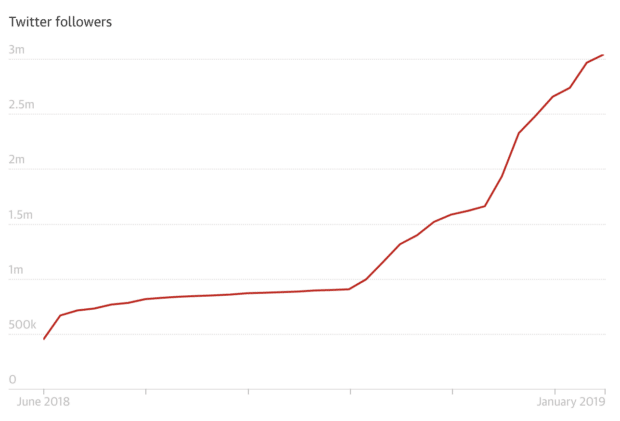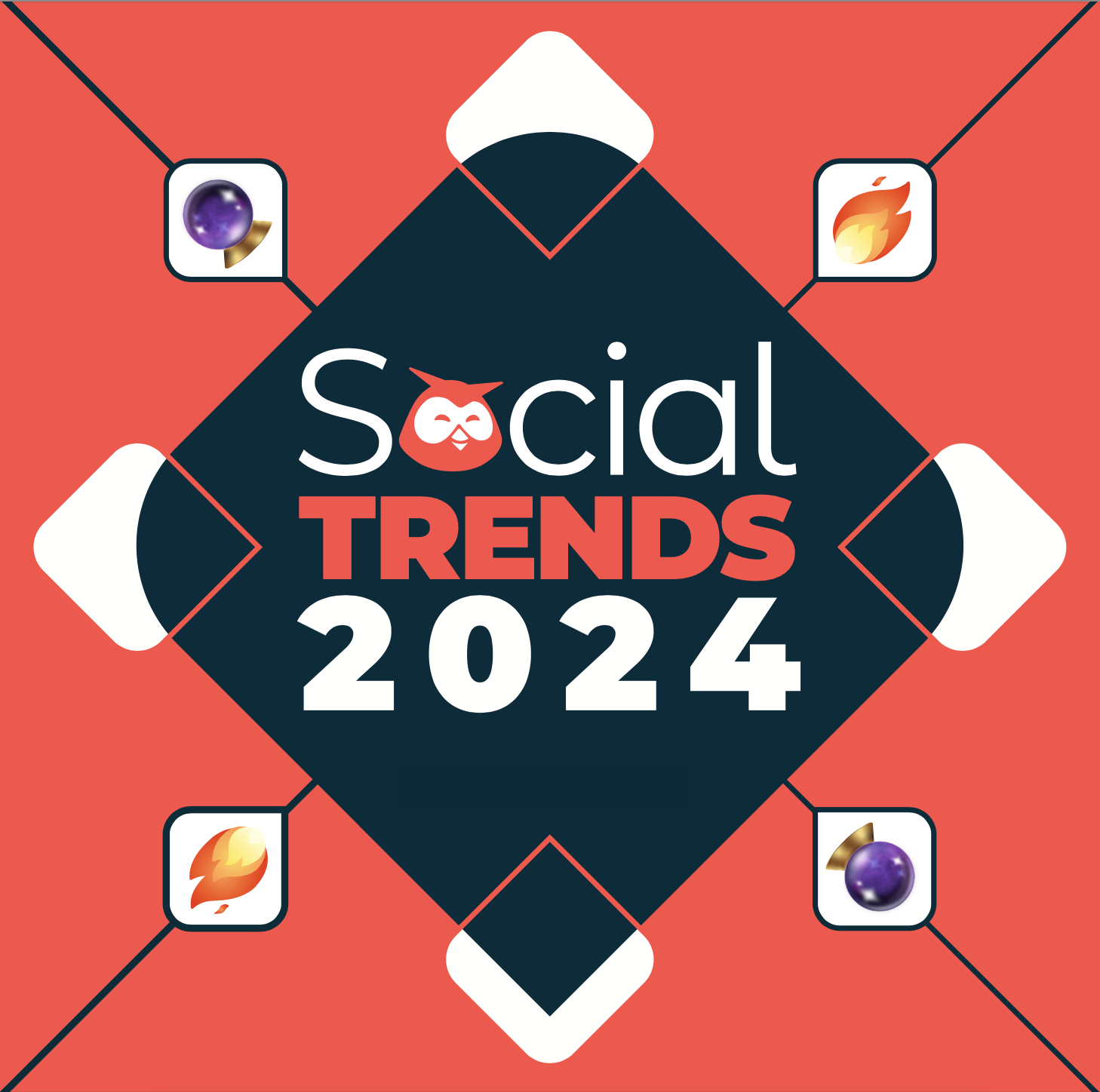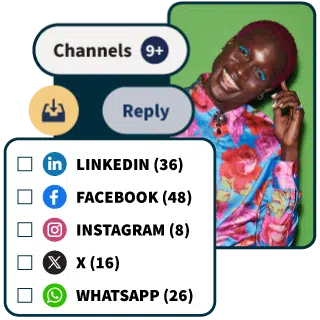Social media and the government go together like peanut butter and jelly. Why? Because social media is an excellent place to communicate with constituents, launch campaigns, and build awareness around initiatives — and it’s an essential tool in crisis communications.
At Hootsuite, we work with many levels of government and fully understand how social media has risen to play a significant role in the communications strategies of government bodies, politicians, and lawmakers worldwide.
Read on to discover how all levels of government, from municipal to provincial to federal, can and should use social media.
Download a free bundle of social media tools designed specifically for government — including post ideas and templates for social media policies, strategies, reports, and crisis communications.
Download nowEngage with the public
Whether you focus efforts on TikTok, Twitter, Facebook, or a different platform entirely, social media will always be a solid place to keep the general public informed and updated about important issues and engage with an audience on a deeper level.
@trafficservices #Inverted ♬ original sound – Toronto Police Traffic Unit
The Toronto Police Traffic Service Department, for example, hosts regular AMA (ask me anything) sessions on TikTok. A representative fields questions on everything from whether people in labor can run red lights (no, apparently!) to the legality of after-market steering wheels.
Communicating and engaging with constituents will help establish and build credibility and trust, as long as you don’t use social media to broadcast messages and actually engage with people who follow you. More on this later!
If you’re serious about using social media to mobilize voters, check out Nextdoor, an app that local governments use to organize town halls, educate citizens on safety issues, and engage community groups.
Show people who you really are
We’ll level with you here… politicians don’t exactly have the greatest rep’. Stereotyped as dishonest, greedy, and a bit sleazy, there’s an opportunity to shift perceptions by using social media for government communications and building a personal brand that is built on transparency.
The U.S. representative for New York’s 14th congressional district, Alexandria Ocasio-Cortez (commonly known as AOC), has done this to tremendous impact via her Twitter account.
By being authentically herself and using photos to support the anecdotes and facts she shares with her constituents, AOC has substantially grown her following and created a personal brand for herself that’s relatable, honest, and bona fide. This authentic approach helped AOC scale her presence on the platform by 600% in seven months.

Source: The Guardian
Social media also humanizes politicians and makes them more accessible and accountable to the general public. Of course, this can backfire if a politician posts social media content deemed socially unacceptable. This is your warning that whoever is in charge of a government social media account has to know what is and what is not acceptable to share (we’re looking at you, Anthony Weiner!)
Crisis communication
There’s been more than enough crises’ happening across the globe in the past few years. The COVID-19 pandemic, Brexit, the January 6th insurrection, and the occupation of Ukraine by Russian forces are a few instances where choices out of the general public’s control or decisions from lawmakers have impacted the world.
When events like those mentioned above occur, people turn to social media to seek out and source information, keep up-to-speed with the latest news, and quell their fears by laughing at a few memes.
People also look to the government for leadership when times get difficult, so it makes sense that lawmakers, politicians, and governments use social media as a platform to manage crisis comms and provide regular, official updates to citizens across the world.
On the flip side, a crisis and social media can quickly become a breeding ground for misinformation. For example, during the COVID-19 pandemic, almost 50% of US adults saw a lot or some fake news about the crisis, and almost 70% say that fake news causes a great deal of confusion.
To counteract this, governments must invest in social media listening to help them identify inaccuracies and respond accordingly — especially as citizens will be looking to government social media accounts to provide them with accurate and objective information.
But don’t feel like you have to engage with every false comment or post you come across in your social listening efforts. Some content might be too wildly incorrect to warrant a reply. However, if you see many social media users spreading misinformation, use official channels to set the record straight.
Need more intel? Read How to Use Social Media for Crisis Communications and Emergency Management and set your organization up for success.

See the latest data and discover the top social media trends specific to government — and craft a strategy that will delight and engage your constituents.
Get the reportLaunch and grow campaigns
Social media isn’t just a place for businesses to share their latest product launch or grow their business with engagement and community. Politicians understand the power of a virtual town hall to launch their own initiatives and ideas.
Additionally, social media is an excellent space to test campaign messaging. The strategy is low stakes, and you get instant feedback from people around the world. Social media is also an opportunity to go viral, see what’s trending, and measure your relevancy.
Politicians can also use social media to align themselves with initiatives and trends. In the example below, US Senator Elizabeth Warren tells her audience where she stands on the US Roe vs. Wade situation.
Low cost (but high stakes)
Political campaigns run on donations, so saving money is always at the forefront of government decision-making. Long before social media existed, politicians and governments had to use traditional media, e.g., television ad slots, newspapers, and door-to-door flyering, to raise the profile of candidates. This was a high-cost initiative that had an immeasurable impact.
In contrast, social media provides the government with a low-stakes entry point to build awareness of its initiatives, grow personal brands, and engage with the general public. The strategy is entirely measurable, so you can actively see how your campaign budget is spent and which social campaigns have the most significant impact.
If you need a few pointers, check out our guide on How to Prove and Improve Your Social Media ROI for valuable tips and insights on measuring campaign performance.
Engage citizens with the only tool that makes it easy to communicate, deliver services, and manage crises.
Messaging is tricky to get right
In 2014, South Dakota launched a campaign to warn people against jerking the steering wheel when swerving on black ice. The hashtag selected by the state’s Department of Public Safety? The sexually suggestive double entendre “Don’t Jerk and Drive.”
Ultimately, the campaign was pulled, and Trevor Jones, secretary of the Department of Public Safety, said in a statement, “This is an important safety message, and I don’t want this innuendo to distract from our goal to save lives on the road.” Fair enough!
Social media and government communications don’t always work out as they should, and sometimes, even what seems like the greatest campaign idea can backfire.
Sometimes, social isn’t the right thing to do
Social media is a place where headlines are created, storms whipped up, and opinions are shared. Unfortunately, this can have a negative impact on sensitive or delicate political situations.
In February 2022, WNBA star and American citizen Brittney Griner was detained in Russia on a drug-smuggling allegation, but little to no fanfare was created on social media—not even a trending #FreeBrittney.
The decision not to create awareness of Brittney’s case was a conscious choice due to the political tension between the US and Russia regarding the occupation of Ukraine. The thought is that Griner’s status as a Black, openly lesbian athlete could lead to her becoming a political pawn in heightened negotiations between Russia and the US regarding the conflict in Ukraine.
Regarding the case, there’s been no public callout from President Joe Biden or high-profile other US officials to bring awareness to Griner’s situation, and for now, maybe that’s the best thing to do.
You will get called out
Social media is a harsh reality, and people will call you out, so make sure what you say is true.
Here’s a brilliant example from Congressman Eric Swalwell, who Tweeted a photo of a Pride flag with the caption, “I fly these flags 365 days a year.” Unfortunately, Swalwell’s followers quickly pointed out that the flag still had creases from being unpackaged moments earlier. Better luck next time, Eric.
I fly these flags 365 days a year. pic.twitter.com/MsI1uQzDZ0
— Rep. Eric Swalwell (@RepSwalwell) May 24, 2019
You will become a meme
I am once again reminding you that social media is a place where you can become a meme.
(And in case you missed it, below is the infamous Bernie Sanders meme that spread like wildfire across social media in early 2020).
Often, the results of having your words and image turned into a meme are fairly harmless. But proceed with caution, as the way they are used will be out of your control.
There are two types of social media accounts: soapboxes and dinner parties. A soapbox social media account focuses on themselves. They use social media to broadcast messages and issues without engaging with their audience.
On the other hand, a dinner party social media account invites audiences in and creates a dialogue with them. They encourage discussion and engagement between the host (you) and the guests (your audience).
You want to make sure you’re running a dinner party account for social media and government communications. Here are five tips on how you can do exactly that.

Grow on social media while avoiding security and compliance risks. Learn how to connect with your constituents, collect feedback, respond to crises, and more.
Watch now1. Learn where your constituents spend time (online)
You need to understand the channel where your target audience hangs out so that you’re not wasting valuable time and resources campaigning into the void.
For example, if you’re a politician relying on swaying younger voters to carry a ballot, you’ll probably want to focus on TikTok or Instagram Reels because this is typically where Gen-Z spends the most time. Similarly, if you want to whip up left-leaning men with a college degree into a frenzy, focus your attention on Twitter.
Remember AOC, who we chatted about earlier? In 2020, she hosted a video game live stream on Twitch to help her reach younger audiences who may not be familiar with or interested in politics.
Anyone want to play Among Us with me on Twitch to get out the vote? (I’ve never played but it looks like a lot of fun)
— Alexandria Ocasio-Cortez (@AOC) October 19, 2020
Marketing on Twitch might not suit every political candidate, so it’ll be your decision whether you think the streaming platform is the correct place for you to engage with an audience. And if you need help understanding how to uncover your target audience on social media, wrap your eyes around How to Find and Target Your Social Media Audience to get started.
2. Share relevant, valuable content and information
Build audience trust and engagement by sharing relevant and interesting content, and audiences will naturally turn to you as a valid source of information and knowledge.
The BC Parks Instagram account does this well. The organization uses Instagram to share information, tips, and insights into what’s happening across the province’s extensive roster of parks.
3. Keep citizens engaged
Would you ever attend a dinner party and sit there silently, not joining in the conversation? Obviously not, and social media is no different. Government officials, lawmakers, and government accounts need to engage with their audiences by replying to messages, joining conversations, and answering questions.
Remember that social media is all about creating community. So ask questions, create opinion polls (Twitter has a great feature that allows you to do this!), and respond to comments from your followers—you never know whether your response will change a voter’s mindset.
You can even repost content posted by your constituents as a form of engagement, like the Government of New Jersey retweeted these photos of a beautiful sunset in Central New Jersey.
Beautiful #sunset tonight in Central Jersey. @NJGov really knows how to show off its colors. #NJwx pic.twitter.com/rvqiuf8pRY
— John Napoli (@WeenieCrusher) May 17, 2022
If you’re struggling to keep up with all the messages you receive, onboard a tool like Hootsuite, where you can effortlessly streamline your comms into one tidy dashboard.
With Hootsuite’s Inbox, you can bridge the gap between citizen engagement and crucial online communications — and manage all of your social media messages in one place. This includes:
- Private messages and DMs
- Public messages and posts on your profiles
- Dark and organic comments
- Mentions
- Emoji reactions
… and more.
The all-in-one agent workspace makes it easy to
- Track the history of any individual’s interactions with your social accounts across platforms, giving your team the context needed to personalize replies
- Add notes to individual constituent’s profiles (Inbox integrates with Salesforce and Microsoft Dynamics)
- Handle messages as a team, with intuitive message queues, task assignments, statuses, and filters
- Track response times and CSAT metrics

Plus, Inbox comes with handy automations:
- Automated message routing
- Auto-responses and saved replies
- Automatically triggered satisfaction surveys
- AI-powered chatbot features

Manage all your messages stress-free with easy routing, saved replies, and friendly chatbots. Try Hootsuite’s Inbox today.
Book a Demo4. Stay secure
A social media security breach will seriously undermine the general public’s confidence in government. Plus, U.S. legislation requires all cloud services used by federal government agencies to meet a meticulous set of security standards known as FedRAMP.
The simplest way to ensure that your accounts stay secure is by onboarding a social media management platform to manage all your social media accounts and activity across multiple teams or people.
Hootsuite is FedRAMP-authorized and comes with two-factor authentication for an additional layer of security. When you centralize your social media management with Hootsuite, you have complete control to review and approve messages, log all activity and interactions, and set up post review and approvals.
If you need more details, read through our step-by-step guide to social media security for more tips on how to protect your organization online, whether or not you use Hootsuite.
5. Remain compliant
Remaining compliant with privacy requirements is critical for any government body. For large organizations with multiple social media practitioners, establishing best practices for social media use can help ensure the collective compliance of all users.
Guidelines towards acceptable and forbidden content, data handling, citizen engagement, and even tone are a few best practice examples organizations can implement to keep their team compliant.
If you manage social for a government or agency using Hootsuite, our partners’ social media archiving integrations make it easy to stay compliant with the Freedom of Information Act (FOIA), General Data Protection Regulation (GDPR), and other public records laws.
In recent years, government bodies and their employees have responded to dramatic shifts in public expectations of political and government discourse.
Innovative policymakers and their staff are quickly adapting by creating highly engaging social content to rally follower support, while also remaining fully compliant and secure. For any government body wanting to capture and maintain public sentiment and engagement, embracing the new era of social media discourse is crucial to success.
Download a free bundle of social media tools designed specifically for government — including post ideas and templates for social media policies, strategies, reports, and crisis communications.
Download nowCDC
During the COVID-19 pandemic, the US Centre for Disease Control and Prevention was understandably a little busy. But that didn’t stop the government agency from pulling off effective COVID-related campaigns and messaging on social media to help keep the general public informed.
Washington State Dept. of Natural Resources
Government social media doesn’t have to be dry or boring — just ask whoever’s running social accounts for the Washington State Department of Natural Resources.
Their Twitter offers timely, relevant information packaged in meme-friendly posts that often go viral.
Parents, please check your kids' candy this Halloween! Just found a magnitude 9 Cascadia megathrust earthquake causing a massive tsunami inside this fun size Snickers bar. pic.twitter.com/NJc3lTpWxQ
— Washington State Dept. of Natural Resources (@waDNR) October 13, 2022
Their alt text game is pretty strong too:

Via Washington State Dept. of Natural Resources on Twitter
FDA
The US Food and Drug Administration is pretty much in charge of saying whether a product or foodstuff is safe for the public to use or not. So, it’s important that their social media channels share factually correct information.
Here are a couple of examples of how the FDA has used social media to this effect.
Folate is important for lowering the risk of serious problems that occur during pregnancy.
Learn how the Nutrition Facts label can help pregnant women make decisions to support a healthy eating pattern. https://t.co/thsiMeoEfO #NWHW #FindYourHealth pic.twitter.com/eFGqduM0gy
— U.S. FDA (@US_FDA) May 12, 2022
Biden #BuildBackBetter
46th President of the United States, Joe Biden, used social media to gain leverage and grow momentum for his Build Back Better campaign throughout 2020 and 2021.
By leveraging the power of the hashtag, Biden’s team was able to ensure a catchy slogan and a measurable campaign by analyzing the success and trends of the hashtag.
Our Build Back Better Agenda will strengthen our economy by lowering taxes on the working and middle class, and reducing the cost of child care, housing, and higher education.
We will grow our economy from the bottom up and the middle out.
— Joe Biden (@JoeBiden) September 28, 2021
What does the government do with social media?
Government agencies and officials use social media for constituent engagement, building awareness around initiatives, and crisis communications.
How does local government use social media?
Local governments use social media to connect with citizens, promote events and local initiatives, and recruit new employees.
What social media platforms are the best for the government?
Government agencies and officials of all levels should be present on the social media platforms used by their constituents. The answer will differ depending on where your agency operates and who you’re trying to reach with your online communications. That said, many people use Twitter to access news and updates from politicians, so it might be a good place to start.
Inform and engage on social media with Hootsuite. From a single dashboard, you can schedule and publish content to every network, monitor relevant conversations, and measure public sentiment around programs and policies with real-time social listening and analytics. See it in action.
See why Hootsuite is the #1 social media tool for government. Engage citizens, manage crises, and reduce risk online.
Book a Demo






